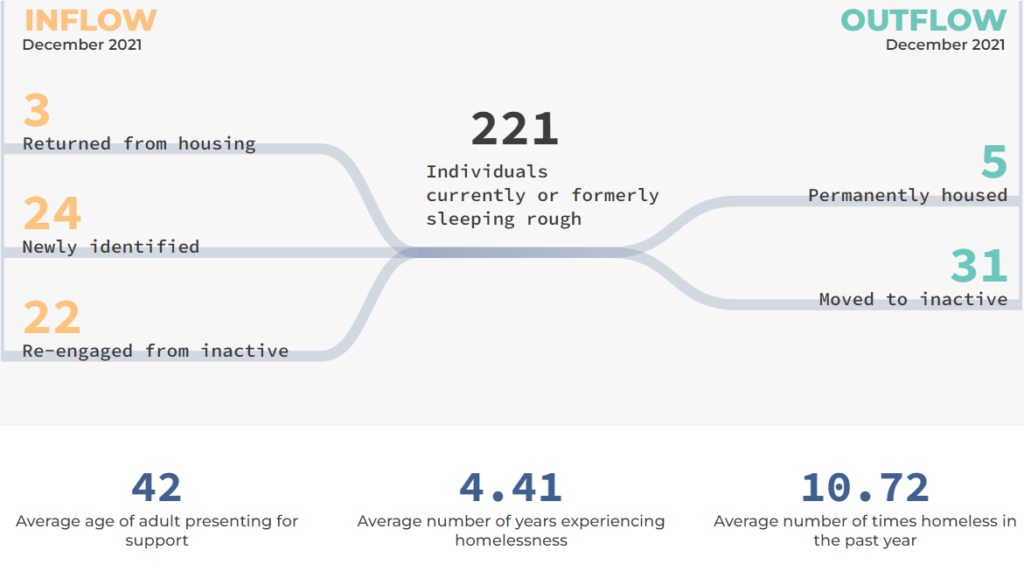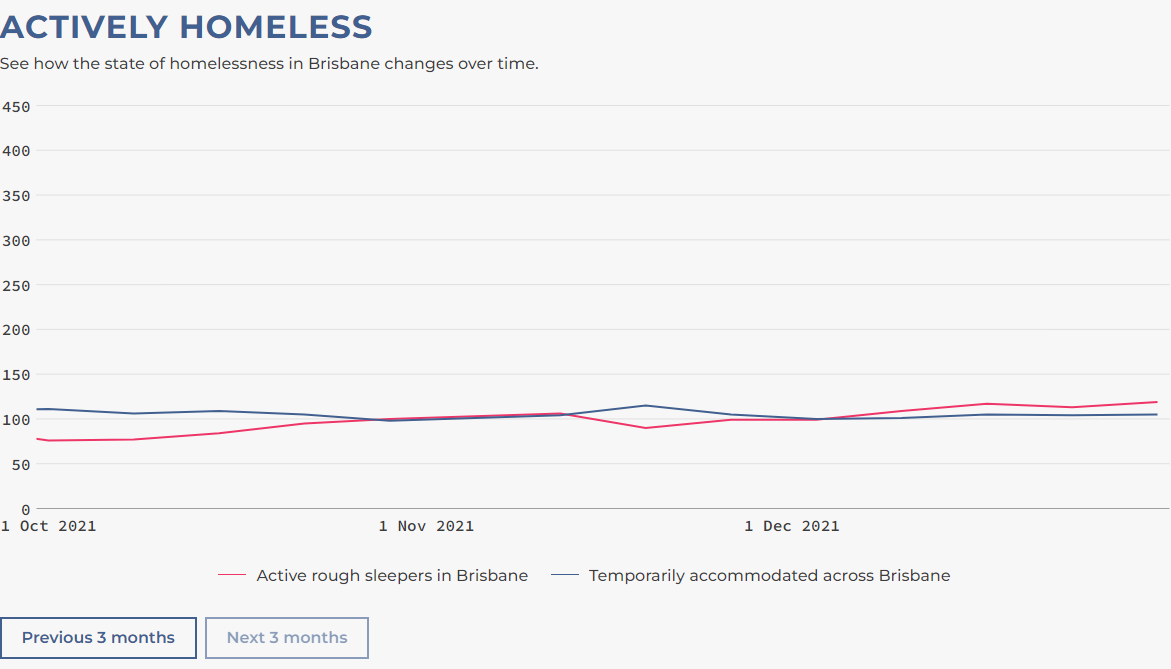Homelessness is solvable.
Track our progress
Logan Zero Project Dashboard
Real time data helps us to get a true picture of homelessness in Logan and track our progress towards ending homelessness. We use the Logan Zero homelessness data to understand how people move in and out of the system, and to understand how the system is responding. From this we recommend and advocate for system improvements to end homelessness.
Definitions and caveats
By Name List (BNL) | A by-name list is a comprehensive list of every person in a community experiencing homelessness, updated in real time. |
Household units | Each household that presents will be counted once as a unit e.g. a family with 3 people will be considered 1 household unit. Individuals would also be considered 1 household unit. |
Household types | A) Individual – 25 years or older without any dependents under 18 years old B) Youth – between 16 and 24 years old, living independently, will be given a youth AHVTT C) Family – one or more people with one or more children under 18 years old in their care |
Inflow | People engaged or presenting to a service that identifies a person as homeless either as: – newly identified as homeless on the BNL – returning from housing (i.e. was housed and then returned into homelessness system) – returning from inactive (i.e. was inactivated after 90+ days of no updates or institutionalised and returned into homelessness system) |
Outflow | People who have exited homelessness either as: – permanently housed (i.e. housed with security/tenure) – moved to inactive (was inactivated after 90+ days of no updates, institutionalised, or moved out of community) – deceased |
Actively homeless | People who are currently experiencing homelessness |
Rough sleeper | People sleeping in outdoor areas or place not meant for habitation most nights e.g. streets, parks, cars, etc.. |
Temporarily sheltered | People who are in a form of shelter that does not have a tenancy/stability e.g. hotels, motels, couch surfing, crisis accommodation, etc.. |
Functional Zero | A milestone that needs to be sustained to indicate that a community has measurably ended homelessness for a population. Functional zero is the state at which a population (e.g. rough sleepers) is no greater than the six monthly average of housing placements and is maintained across a period of time. When it is achieved, homelessness is rare and brief for that population. |
Improvement median | Median (middle value) of rough sleepers. For Logan Zero, the median indicates that if a system continued operating without changes, it would likely continue to around the median number of people. |
Quality By Name List data certification | Logan Zero works with Community Solutions and AAEH to undertake a quality BNL certification via the use of a scorecard. The scorecard helps to assess that a community has full coverage, policies, and procedures in place to capture and maintain data and appropriate data infrastructure. This helps to ensure that data has comprehensive coverage, is representative, and real-time. |
Please note:
Data released by the Logan Zero campaign is indicative information of homelessness in the Logan Local Government are (LGA) and must be considered with the caveats below:
Project phase and data quality certification:
- The Logan Zero campaign is currently in the community building phase. Data will fluctuate as organisations become familiar with data entry and the process becomes embedded into workflows.
- It is not a mandatory database for participating organisations. Contribution is solely based on the goodwill of organisations for a collaborative approach to ending homelessness. Until most organisations are participating (when quality BNL is achieved), data will be under-representative of homelessness in the region.
- Logan Zero is currently working towards a quality BNL certification to ensure data coverage is: representative of services and people experiencing homeless across the region, is real-time, and is person specific.
- Logan LGA includes the Logan city council regions
- Data is not state-wide as is limited to where the support services are in the region. Importantly, some people experiencing homelessness move fluidly between southeast Queensland and other areas.
Data display:
- The data displayed is extracted at the end of each month and may vary from the live database as users are constantly updating information.
- In some cases, the By Name List (BNL) does not receive an update until months after an event.
- The dashboard includes rough sleepers and those in temporary accommodation, however, functional zero is only measured for rough sleeping population as it relates to the current goal.
- The data displayed is by household units based on the main presenting people per household e.g. a family with 3 people will be considered as 1 household unit. This is to account for services that do not have capacity to capture information around family members.
- Household categories are also important to understand housing solutions required e.g. family requiring 3 bedrooms.
- People who do not engage with a service within 3 months are moved to inactive as we are unable to verify their homeless status.
- Young people are suspected to be underrepresented on the BNL data due to lack of youth specialist homelessness services in the region
For further information, please contact Logan Zero team on via email: [email protected]
A by-name list is a comprehensive list of every person in a community experiencing homelessness, updated in real time.
Each household that presents will be counted once as a unit e.g. a family with 3 people will be considered 1 household unit. Individuals would also be considered 1 household unit.
- Individual adult – A single person, greater than or equal to 26 years old
- Individual youth – A single young person between the ages of 16-25 years, detached from their family, that does not have suitable living alternatives and a safe living environment. This includes:
- rough sleeping, couch surfing
- in emergency youth accommodation
- have a history of chronic homelessness
- have transitioned into homelessness from service systems
It doesn’t include young people that are:
- living in government funded group homes or foster care
- in a 6-24 months transitional accommodation such as a Youth Foyer
- that are presenting as newly homeless or episodic homeless where there is capacity to quickly resolve their living situation such as youth runaways, which can be episodic (1-2 nights) but not chronically homeless
Families – A group of people, any age, presenting together e.g. couple without dependents, family with dependents, single parent households, multigenerational family etc
People engaged or presenting to a service that identifies a person as homeless either as:
- newly identified as homeless on the BNL
- returning from housing (i.e. was housed and then returned into homelessness system)
- returning from inactive (i.e. was inactivated after 90+ days of no updates or institutionalised and returned into homelessness system)
People who have exited homelessness either as:
- permanently housed (i.e. housed with security/tenure)
- moved to inactive (was inactivated after 90+ days of no updates, institutionalised, or moved out of community)
- deceased
People who are currently experiencing homelessness
People sleeping in outdoor areas or place not meant for habitation most nights e.g. streets, parks, cars, etc.
People who are in a form of shelter that does not have a tenancy/stability e.g. hotels, motels, couch surfing, crisis accommodation, etc.
A milestone that needs to be sustained to indicate that a community has measurably ended homelessness for a population.
Functional zero is the state at which a population (e.g. rough sleepers) is no greater than the six monthly average of housing placements and is maintained across a period of time.
When it is achieved, homelessness is rare and brief for that population.
Median (middle value) of rough sleepers. For Logan Zero, the median indicates that if a system continued operating without changes, it would likely continue to around the median number of people.
Logan Zero works with Community Solutions and AAEH to undertake a quality BNL certification via the use of a scorecard. The scorecard helps to assess that a community has full coverage, policies, and procedures in place to capture and maintain data and appropriate data infrastructure. This helps to ensure that data has comprehensive coverage, is representative, and real-time.
Dashboard
Use this dashboard to understand who is homeless in the region and how Logan Zero is progressing towards the goal.
We advise you refer to the definitions and caveats prior to viewing the information.
Watch this short video that describes how by name data helps communities end homelessness.
Targets



